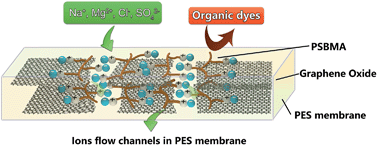Surface zwitterionic functionalized graphene oxide for a novel loose nanofiltration membrane†
Abstract
Surface zwitterionization of graphene oxide (GO) was firstly conducted by grafting poly(sulfobetaine methacrylate) (PSBMA) onto the GO surface via reverse atom transfer radical polymerization (RATRP). Then, a novel type of GO-PSBMA/polyethersulfone (PES) loose nanofiltration membrane (NFM) was constructed by mixing with modified GO composites via phase inversion. FTIR, XRD, TEM, XPS and TGA were applied to analyze the chemical composition and morphology, confirming a favorable synthesis of GO-PSBMA composites. Besides, the effect of the embedded GO-PSBMA nanoplates on the morphology and overall performance of the hybrid membranes was systematically investigated based on the SEM images, water contact angle, zeta potential, and fouling parameters. It was found that the water flux of the hybrid membrane was greatly enhanced from 6.44 L m−2 h−1 bar−1 to 11.98 L m−2 h−1 bar−1 when the GO-PSBMA content increased from 0 to 0.22 wt%. The antifouling tests revealed that the GO-PSBMA embedded membranes had an excellent antifouling performance: a high flux recovery ratio (ca. 94.4%) and a low total flux decline ratio (ca. 0.18). Additionally, the hybrid membranes exhibited a distinct advance in the mechanical strength due to the addition of highly rigid GO. Notably, compared with unmodified membranes, the hybrid membranes had a higher retention of Reactive Black 5 (99.2%) and Reactive Red 49 (97.2%), and a lower rejection of bivalent salts (10% for Na2SO4) at an operational pressure of 0.4 MPa, rendering the membranes promising for dye/salt fractionation.


 Please wait while we load your content...
Please wait while we load your content...